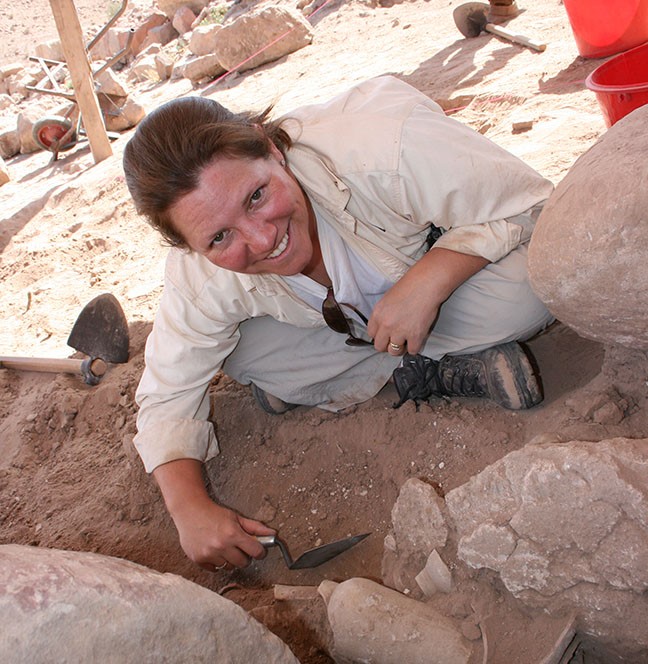Affiliation: The College at Brockport, SUNY

Jennifer Ramsay is Associate Professor in the Department of Anthropology at the College of Brockport, SUNY; she holds her degrees from Simon Frasier University (Ph.D.), the University of Sheffield (MSc.), and the University of Victoria (B.A.). Her research interests are archaeobotany, subsistence reconstruction, trade patterns, environmental change and land-use patterns. She is Assistant Director and Project Archaeobotanist for the Petra North Ridge Project, and also serves as the Archaeobotanist for an array of other sites including the Legio excavations for the Jezreel Valley Regional Project , the Khirbet Ishkander Project, the Roman Villa at Grace (Sicily), the Huqoq Excavation Project, the Petra Pool and Garden Complex (where she is also the Fieldschool Director), the Tall al-Umayri Project, and the Roman Aqaba Project. Her recent publications include “A Diachronic Look at the Agricultural Economy at the Red Sea Port of Aila: An Archaeobotanical Case for Hinterland Production in Arid Environments” (with S.T. Parker in The Bulletin of the American Schools of Oriental Research 376, 2016) and “For the Birds – An Environmental Archaeological Analysis of Byzantine Pigeon Towers at Shivta (Negev Desert, Israel), (co-author, Journal of Archaeological Science: Reports, October 2016).
There is extensive evidence from Hellenistic and Roman literary sources for the practice of funerary dining and the provisioning of offerings to the dead. Mortuary behaviors have generally relied on ceramic and faunal remains but rarely are they explored using evidence from plants. My research seeks to gain a better understanding of the role of plants in this type of ritual context through the analysis of botanical remains recovered from Nabataean tomb contexts in Petra, Jordan. Analysis of samples taken from several tombs that were excavated over three seasons (2012, 2014 & 2016) indicates the presence of a variety foodstuff such as Triticum sp. (wheats), Hordeum vulgare (barley), Lens culinaris (lentil), Vitis vinifera (grape), Ficus carica (fig) and Phoenix dactylifera (date). These finds provide intriguing evidence of plants consumed or offered to the dead during ritual events. This study, in association with the analysis of bioarchaeological remains and ceramics, expands our knowledge of Nabataean funerary practices and contributes to a broader understanding of the role of plants in ritual funerary events in the ancient world.
I spent several summers as a graduate student at Caesarea Maritima collecting bags of dirt that I then floated to recover tiny, carbonized plant remains. It was there that I discovered the importance of the neglected, but informative, ‘weed’, which could tell us about the environment, seasonality, and agricultural techniques. I have since been fortunate to work on projects at sites like Petra, Jordan, where the data from the Petra Garden and Pool Complex addressed the questions of how plants functioned in the economy, and how the role of the garden changed through time. Additionally, plant remains I analyzed from Nabatean-period tomb deposits there highlighted the role plants played in funerary contexts in the ancient world. Plant remains also allowed for a better understanding of the scale and timing of local agricultural production at Bir Madhkur, which lies in the hyper-arid hinterland of Petra. At other sites, for example the Islamic period site of Kinet Höyük in Turkey, the plant remains indicated cereal agriculture, but also documented the emergence of a cotton boom, which is attested to in ethnohistorical sources but had rarely been confirmed through archaeobotanical evidence. From examining Neolithic plant remains from the Black Desert in Jordan that indicate a much more verdant environment in the past, to discovering what plants can tell us about provisioning the Roman Army in the East, and even to understanding the role pigeons played in ancient agriculture, plant remains offer vital evidence to our understanding of the past.
The analysis of plant remains sheds light on how the rise in military presence in the arid regions of southern Jordan and Israel during the Roman and Byzantine periods influenced agricultural production. Archaeobotanical evidence from Aila, Humayma, Bir Madhkur, and Yotvata confirms local agricultural activity during these periods. The discovery of cereal grains, legumes, crop by-products (e.g., chaff, culm, and rachis segments), and weeds typical of crop fields indicates successful local agriculture in this arid region in ancient times. Despite the stable environmental conditions in southern Jordan and Israel since the Roman and Byzantine periods, these sites are either surrounded by ancient agricultural fields or exhibit evidence of historical local production. This suggests that water management techniques in antiquity were more advanced than currently acknowledged, as modern cereal agriculture is absent in these areas today. These findings highlight the landscape changes due to the necessary local agricultural production to support the increased Roman military presence and illustrate the potential of dry-land agricultural techniques in arid environments.